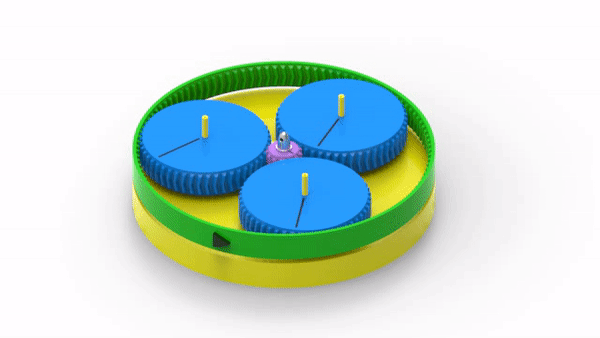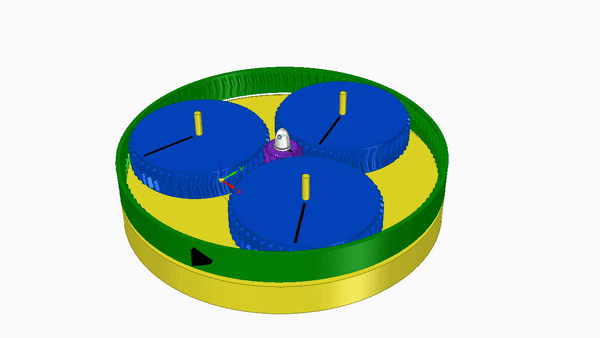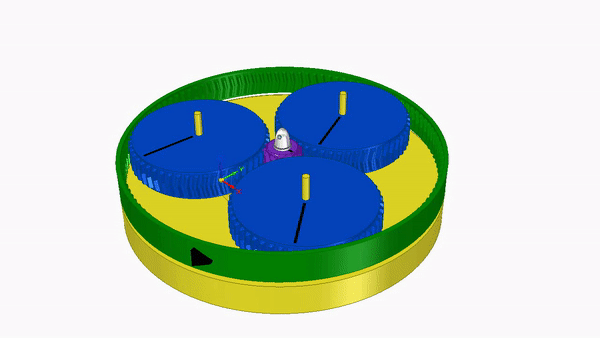166RPM


1666RPM

10:1 Gearbox reduction for Brushless A2212 Motors
To make the experience fit your profile, pick a username and tell us what interests you.
We found and based on your interests.
166RPM

1666RPM
Create an account to leave a comment. Already have an account? Log In.
Oh, and you want the planet axles as separate parts made out of hardened and polished steel (assuming you don't want to use ball bearings). If practical the planet carrier should support the planet axles on both sides - especially when using inferior material like 3D printed plastic.
You also need a way to hold the planets in place (gravity works well for many planets out there) and you need washers to void the planets rubbing against the planet carrier.
Relying on the herring bones to hold the output in place is not a great solution (depending on what you use the gear box for). One solution is using a big bearing around the ring gear/planet axles. An easier and cheaper but also weaker solution is to attach it with a ball bearing to the driven axle.
Thanks for all this input. I agree with not obstructing the airflow but for burst operation. (like for say an articulating elbow ) Convection is not that important. Inspiration for this project was from a student group I worked with that made prosthetics. Crating a cheap elbow joint is extremely difficult and expensive. But the A2212 Has 150W of power in a small package. This could Theoretically provide 210in*lb torque at 1 rotation/second. The attached movies were to provide a starting off point to optimize the reduction. My next step will be to make an adapter for a 100:1 Design (https://www.youtube.com/watch?v=wsk3gqiS__M&feature=youtu.be). His video shows a efficiency of 20% which would give us 42 in*lbs. But if I take into account your suggestion of bearings this inefficiency may be reduced
Yeah, I've looked into these "differential" planetary gears already. They look intriguing at first. But they have a couple of issues. Poor efficiency being one. You are probably better off using a conventional two stage planetary gear set which basically has the same amount of gears (although sun and planets are separate for each stage) and the same reduction ratio but does not suffer from all the problems.
Designing this gear box for an elbow joint that does not have to turn 360° gives you a few more options on how to support the joint. For example you can use a bearing on the other end of the motor that connects the upper and lower arm which wouldn't work otherwise. Basically create a bracket in which the other arm rotates in.
Herringbone teeth lock the ring in place. Without a herringbone the ring gear would be able to move in the axial direction.
What advantage do the herringbone teeth provide? My understanding is that they're supposed to be used in applications where helical teeth would produce axial thrust that needs to be managed. Will that be the case here? Or is there another reason for the herringbones?
Become a member to follow this project and never miss any updates
Typically the ring gear is fixed and the planet carrier is used as driven element as this gives a moderately better reduction ratio. This also makes the gear train stronger.
The ring gear shown here is much too flimsy and will deflect and then skip teeth.
A2212 motors have a propeller mount on top but also have a rotating bell. So mounting this on the motor is not trivial. Especially as you must not obstruct airflow to the motor. Using a motor with an axle on the bottom end would make mounting much easier. May be the axle of the A2212 can be turned around.
Note that you need 3 mounting points to the gear box: The input gear (sun) to the motor axle, the output (ring gear or planet carrier) to what ever you are driving and the third part (housing holding the planets or ring gear) needs to be fixed to the stator of the motor.